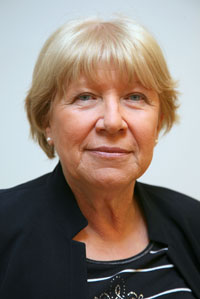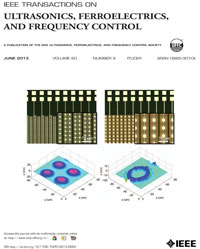In memoriam
 Professor Marija Kosec passed away after a serious illness on 23rd December 2012. Almost everyone called her Marička, a popular Slovenian version of the biblical name.
Professor Marija Kosec passed away after a serious illness on 23rd December 2012. Almost everyone called her Marička, a popular Slovenian version of the biblical name.
She was born on 5th September 1947 in Šinkov turn, about 20 km away from Ljubljana, Slovenia, at that time one of the republics of the former Yugoslavia.
She graduated in 1970 in chemical technology, received her MSc in 1975 and her PhD in chemistry in 1982 at the University of Ljubljana, Slovenia, under the supervision of Professor Drago Kolar. The topic of her Master Thesis was lead-free piezoelectric sodium potassium niobate, which, after being almost forgotten for about 25 years, became extremely popular with the revived interest in environmentally-friendly lead-free piezoceramics. Her first journal paper eventually became the seminal paper on sintering of this still not thoroughly-understood material. Her doctoral thesis involved the study of phase relations in calcium uranate systems, and within this period she mastered the techniques of thermal analysis.
Beginning in 1971 she was employed at the Jožef Stefan Institute, Ljubljana, Slovenia, and in 1997 – 2001 she was Head of the Ceramics Department. In 2002 she became Head of the Electronic Ceramics Department. She performed a part of her doctoral research (1979 – 1980) at the Institute for mineral engineering of RWTH Aachen, Germany. In 1993 she was a visiting scientist at the Ceramics laboratory of Ecole Polytechnique Federale de Lausanne (EPFL), Switzerland. In the years 2004 – 09 she was also leading the Slovenian Centre of Excellence, called “Materials for electronics of next generations and other emerging technologies”, and since 2009 the Centre of Excellence “Advanced Materials and Technologies for the Future” (NAMASTE).
Her main research interests included synthesis and processing of ceramics in different forms: particles, solution-derived thin films, thick films, 2D or 3D structures, bulk electronic ceramics, predominantly ferroelectrics and piezoelectrics. Her contribution was in understanding and thus controlling the synthesis of application-important multi-component oxides, mainly perovskites, both in solution, in colloidal systems or suspensions, in powder mixtures by mechanochemical or classical solid-state reactions and processes. Using extensive processing knowledge and skills, her group synthesized transparent electro-optic ceramics. The research of lead-free complex perovskites resulted in the discovery of a new group of relaxors and highly-efficient piezoelectric K0.5Na0.5NbO3 single crystals. In chemical solution deposition of ferroelectric thin films she explained complicated reactions taking place in solution, which allowed the processing temperatures of the films to decrease. She focused on the integration of thick films on different substrates for ceramic micro-electro-mechanical systems (MEMS). She understood the importance of the processing-properties relationship, and she could extremely successfully cross the barriers of different backgrounds and terminologies, which was evident from her numerous collaborations with researchers from complementary fields of physics and electronics. Furthermore, she endeavored to merge basic science with applied research and development and to strengthen links between academia and industry.
She was author or co-author of more than 300 scientific papers in international journals and about 15 chapters in books. She gave more than 150 invited talks at international conferences and at different research institutions including Max Planck Institut, MIT, Tokyo Institute of Technology, and at important Japanese producers of electronic components including Murata, TDK, Panasonic and Toshiba. In 2000 she chaired the Electroceramics conference, in 2003 the European conference Processing of Electroceramics and in 2006 the 4th European Microelectronics and Packaging Symposium.
In 1999 she was appointed Professor of Materials Science at the University of Ljubljana, with courses at the graduate and post-graduate level. She was active in the Jožef Stefan International Postgraduate School, since its establishment in 2004, as its vice-president. She was a visiting professor at Ecole Polytechnique Fédérale de Lausanne (EPFL), Switzerland, Shizuoka University, Japan, and for short periods at a number of other schools. She was Adjunct Professor at Xi’an Jiaotong University, China. She was an inspiring advisor to many PhD students at the University of Ljubljana, Jožef Stefan International Postgraduate School and University of Oulu, Finland.
Marija served as a member or chair of many scientific committees or advisory bodies in Slovenia. In 2007 – 2009 she was the President of the Scientific Council of Jožef Stefan Institute. She was the only female member of the Academy of Engineering Sciences of Slovenia and in the period 2005 – 2006 its president. She was an Ambassador of Science of the Republic of Slovenia (2003), recipient of the Zois award, the highest national science award, in 2006 and of the Puh recognition for the implementation of research results in industry in 2009.
She was active in COST, European Cooperation in Science and Technology framework, since 1991, the year, when Slovenia became an independent country. Since 1999 she was a member of the European Liaison Committee of the International Microelectronics and Packaging Society. In 2001 she became a member of the Ferroelectrics Committee at IEEE. In 2010 she received the Ferroelectrics Recognition Award, IEEE Ultrasonics, Ferroelectrics, and Frequency Control Society for her significant contributions to the processing science and technology of ferroelectric powders, bulk ceramics, thin and thick films.
Besides her work, Marija enjoyed numerous activities. She was often hiking and skiing with her husband. She knew where and when to find mushrooms and how to cook or preserve them. She grew vegetables and flowers in her garden and prepared herbal teas.
Her optimistic approach to life in general and to her research in particular, her sharp mind and her extensive background knowledge, her sincere interest in people and her generous heart will be sadly missed. The Electronic Ceramics Department and the UFFC community will remember her as a special person, able to keep the whole group together and, at the same time, to give to each member of the group individually the right motivation. No words can really explain what Marija was and what she did for science and for people. She was simply Marička.
Barbara Malič and Tadej Rojac
Electronic Ceramics Department
Jožef Stefan Institute
Ljubljana
Slovenia
back to Home Page



